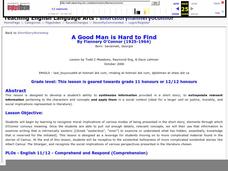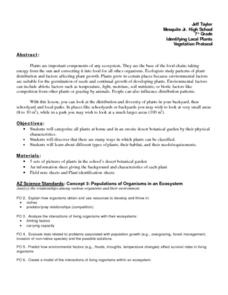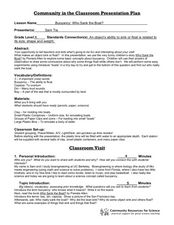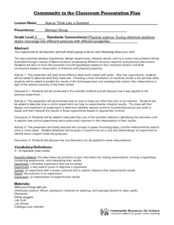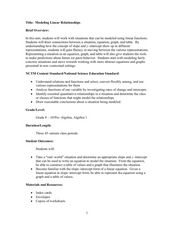Curated OER
Finding Equations
Students make equations from everyday data. They create a graph from the equations. Students predict and analyze the results. Students complete the second scenario on their own and turn in their handout.
Curated OER
From Formal To Slang
Tenth graders define the term slang, explaining its various social, historical, and racial contexts, so as to articulate when it can be appropriately used as a means of effective communication. They use their own personal slang lexicon,...
Curated OER
Character Sketches
Students are introduced to the types of characters found in short stories. They read a short story in class and produce sketches of the protagonist and antagonist. Finally, they create their own characters and write about them in their...
Curated OER
A Good Man is Hard to Find
Young scholars, in groups, read and analyze the short story, A Good Man is Hard to Find, by Flannery O'Connor. They present their findings tot he rest of the class and then connect the various themes discussed to outside material, events...
Curated OER
The Theory of Comparative Advantage
Students take a closer look at comparative advantage. In this economics lesson, students discover details about opportunity cost, comparative advantage, and absolute advantage. Students participate in a simulation that requires them to...
Curated OER
The Art of Science: Gravity
Through a series of experiments and demonstrations, fifth graders will learn about gravity. They will make predictions, drop various objects, write down their observations, and try to understand gravity through balance. This lesson seems...
Shodor Education Foundation
Graphing and the Coordinate Plane
Ready to introduce your class to the coordinate plane? This website includes a detailed lesson plan that includes two interactive games to help learners practice graphing ordered pairs. The scripted discussion is a little cheesy and a...
Curated OER
Plant Diversity and Distribution
Learners construct a defined plot on school grounds and observed patterns in plant life. They count trees, shrubs, cacti and record on a data sheet. They compare data and generate a plant diversity overlook for their school.
Curated OER
Alfalfa Butterfly/Caterpillar Lifecycle Investigation
Young scholars collect and record data. They identify sex of butterflies. They make conclusions based on collected data.
Curated OER
Formula for Fitness
Many youngsters don't understand that fitness is a life-long endeavor, and that it really pays off to be healthy. Use a spreadsheet to document progress in a fitness plan to see if there really in a benefit to running and exercise. Adapt...
Curated OER
Early Exploration of North America
Third graders "travel" from Europe to North America as Columbus did. They organize the information into chronoglogical order.
Curated OER
Canada, O Canada
Students study the similarities and differences between Canada and the United State in this unit. They examine geography, government and culture as they "travel" through Canada.
Curated OER
A Sentence for Life
What is a sentence? Second graders will explore the components of a sentence in the ten lessons of this unit. The subject, predicate, the process of proofreading, punctuation, and sentence sequence are analyzed in this unit. Handouts and...
Curated OER
Early Americans - Their Culture and Law
Students examine the laws, food, clothing, and shelter of early American Indian cultures. They conduct research, answer questions, and plan and map out an early American Indian village.
Curated OER
Whose Lunch Money Is It?
Students examine the legal issues involved when there is a dispute over lunch money at school. They read the case study, discuss the two points of view, and illustrate a picture of how they would solve the problem.
Curated OER
BrainStorming
Young scholars, through modeling and independent practice, are introduced to the different methods of brainstorming. They explore and engage in these different approaches individually, in pairs, and as a group.
Curated OER
The Giver
Tenth graders identify the different ideas, emotions that different colors represent the significance of color in real life. They examine the significance of the lack of color in The Giver and the movie Pleasantville. They develop...
Curated OER
U.S. History: Antebellum Heroes and Villains
Eighth graders research and write reports on key figures of the Antebellum Period. The projects also include pictures, bibliographies, and timelines about their assigned figure. In addition, 8th graders present oral reports to classmates.
Curated OER
Buoyancy: Who Sank the Boat?
Students examine whether objects will sink or float. In this buoyancy instructional activity students bring in objects and experiment to see if they sink or float.
Curated OER
Survival Strategies and Adaptation in Insects
Third graders investigate insects and their adaptations that help them survive. In this survival strategies lesson, 3rd graders view photographs of insects and discuss the adaptations that each one uses to survive, including camouflage...
Curated OER
How to Think Like a Scientist
Fifth graders study the scientific method and understand how to apply it. In this "thinking like a scientist" lesson students complete several activities.
Curated OER
Green Buildings Virtual Tour
Students fill out a worksheet after researching green buildings by taking a virtual tour. In this green buildings lesson plan, students use Google Earth to research green buildings.
Curated OER
Modeling Linear Relationships
Young scholars graph lines using the slope and y-intercept. In this algebra lesson, students create data using tables and equations. They use their data to make predictions and draw conclusion.
California Academy of Science
Where Do I Put My Trash?
Where does the trash go after you put it in the garbage can? The class discusses sustainability, recycling, compost, and landfills as they play as fun relay game. In teams, they race to be the fastest group to successfully sort their...





